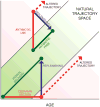Replenishing our defensive microbes
- PMID: 23836415
- PMCID: PMC4102301
- DOI: 10.1002/bies.201300018
Replenishing our defensive microbes
Abstract
Large-scale characterization of the human microbiota has largely focused on Western adults, yet these populations may be uncharacteristic because of their diets and lifestyles. In particular, the rise of "Western diseases" may in part stem from reduced exposure to, or even loss of, microbes with which humans have coevolved. Here, we review beneficial microbes associated with pathogen resistance, highlighting the emerging role of complex microbial communities in protecting against disease. We discuss ways in which modern lifestyles and practices may deplete physiologically important microbiota, and explore prospects for reintroducing or encouraging the growth of beneficial microbes to promote the restoration of healthy microbial ecosystems.
Keywords: antibiotics; ecology; gut microbiota; human microbiome; hygiene hypothesis; pathogens.
Copyright © 2013 WILEY Periodicals, Inc.
Figures


References
-
- Jaenike J, Unckless R, Cockburn SN, Boelio LM, Perlman SJ. Adaptation via symbiosis: recent spread of a Drosophila defensive symbiont. Science. 2010;329:212–5. - PubMed
Publication types
MeSH terms
Grants and funding
LinkOut - more resources
Full Text Sources
Other Literature Sources

